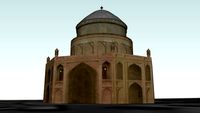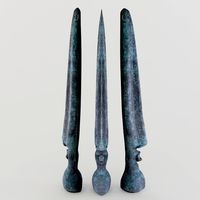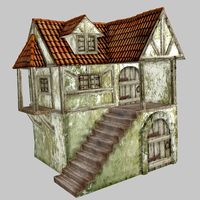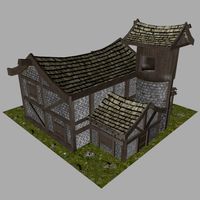CG Trader

Medieval Ethnic Tent Set
by CG Trader
Last crawled date: 1 year, 10 months ago
Medieval Ethnic Tent Set ethnic tent
......................
old version
........................
sitting
.....................
skin stretching
.........................
animal cage
.........................
shaman drum
.........................
shaman stamp
...........................
an excellent set
..........................
shaman history
................ Shaman and Shamans redirect here. For other uses, see Shaman (disambiguation).
Part of a series on
Anthropology of religion
Khagdaev1.JPG
Buryat shaman on Olkhon Island, Siberia
Basic concepts
AfterlifeAnimismAuguryCommunitasComparative religionDivinationDivine languageEvolutionary origin of religionsFetishismGreat SpiritHenotheismInitiationLiminalityMagic (supernatural)ManaMonotheismNympholepsyOraclePolytheismRite of passageRitualSacred languageSacred–profane dichotomySacred siteShamanismSoul dualismSuperstitionTheories about religionsTotemTranstheismVeneration of the dead
Case studies
Related articles
Major theorists
Journals
Religions
Social and cultural anthropology
vte
This article is part of a series on
Alternative medicine
Outline-body-aura.svg
General information
Fringe medicine and science
Conspiracy theories (list)
Classifications
Traditional medicine
African MutiSouthern AfricaAyurveda DoshaMVAHBalneotherapyBrazilianBush medicineCambodianChinese Blood stasisChinese herbologyDit daGua shaGill plate tradeMeridianMoxibustionPressure pointQiSan JiaoTui naZang-fuChumashCuranderoFaith healingHilotIranianJamuKamboJapaneseKoreanMien ShiangMongolianProphetic medicineShamanismShiatsuSiddhaSri LankanThai massageTibetanUnaniVietnamese
Diagnoses
vte
Shamanism is a religious practice that involves a practitioner (shaman) interacting with what they believe to be a spirit world through altered states of consciousness, such as trance.[1][2] The goal of this is usually to direct spirits or spiritual energies into the physical world for the purpose of healing, divination, or to aid human beings in some other way.[1] Beliefs and practices categorized as shamanic have attracted the interest of scholars from a variety of disciplines, including anthropologists, archaeologists, historians, religious studies scholars, philosophers and psychologists. Hundreds of books and academic papers on the subject have been produced, with a peer-reviewed academic journal being devoted to the study of shamanism. In the 20th century, non-Indigenous Westerners involved in counter-cultural movements, such as hippies and the New Age created modern magico-religious practices influenced by their ideas of various Indigenous religions, creating what has been termed neoshamanism or the neoshamanic movement.[3] It has affected the development of many neopagan practices, as well as faced a backlash and accusations of cultural appropriation,[4] exploitation and misrepresentation when outside observers have tried to practice the ceremonies of, or represent, centuries-old cultures to which they do not belong. History books cite that Turkic people used to practice shamanism. A shaman is a person with the ability to contact supernatural forces. Reminiscent of modern-day psychics, shamans would lose themselves in the state of trance through their own methods such as chanting prayers while playing a frame drum. They had special clothing, used drums or other certain instruments, danced and had knowledge of things like spirits or jinns that ordinary people cannot see or hear. Shamans are not poets at all, but their prayers are generally in the form of a poetry that contains meaningless but magical words. Shamans were tribe' medicine men rather than men of religion we see in the Western religions. They are said to foretell the future as well. Shamans would heal people by killing and eating the evil spirit and talk about the things happening in the spiritual world. The talents of shamans were often seen as hereditary and were both men and women. Shamans were commonly seen in a vast region from Siberia to India, Africa and Americas. Because they are referred to as religious practitioners, the religions we come across in these regions are called shamanism. Indeed, shamanism is not an independent religion, it is a system of supernatural forces that is part of religions. It would not be wrong to say that shamanism can be observed in every religion. However, calling the shamans' faith religion makes the whole matter more complicated. In ancient Rome, people believed in an afterlife and spirits were very important for people. Salius priests, who were dancing, singing and making music by striking weapons in each other's hands, were similar to shamans. The resemblance between shamans and Druids, the Celtic priests appearing in white clothes, who used to make medicine from the mistel by collecting them from red oak, is also striking. Shamanism is a technique and practice often found in animism, which is the belief that plants, animals, rocks and other living things and objects possess a spiritual essence. People who possess specific powers are believed to influence nature through words and gestures, and these words and gestures are related to what is desired. For instance, to cure an illness, a shaman would make symbolic gestures to dismiss the illness and say something like: The parrot flew away / The illness flew away. If rain is desired, a shaman would make a gesture similar to pouring water or do a war dance before setting off for battle. Apart from these, symbolic objects were also used in rituals. One theory of the etymology of the word shaman is that is comes from Tungusic languages, related to the root a man who loses self-control but it also had an Indo-European cognate in a word for a Buddhist ascetic. The world shaman was transferred to French through Russian. Old Turkic people used the world kam instead of shaman. However, the Orkhon Inscriptions of the eighth century, which offers valuable information on ancient Turkic people's lifestyle and history, does not mention the world kam. Blue sky According to the information that is more or less conclusive, most Turkic people believed in a single creator at times before they converted to Islam. They gave various names to their creator like Chalap, Ogan, Bayat and Ülgan and used them based on the creator's features they would like to highlight. These words were used to refer to God even after they converted to Islam. Chalap means creator and all merciful, Ogan means mighty, Bayat means abundant and Ülgan means greatness. These names were used in Yusuf Has Hajib's 10th century politics and ethics book Qutadghu Bilig and also in many works on Anatolian literature. The world Chalabi, which was much used in the Ottoman period, is derived from the world chalap as well. Likewise, God shows mercy to all human beings on earth and equally treats them with the attribute al-Rahman (all-merciful), and a person with the attribute Chalabi behaves well to all, both friend and enemy. Ancient Turkic people believed in the superiority of the creator's will. They also believed in fate and accepted everything that happened since it was the creator's will. They referred this creator as Kök Tangri (Sky God). In Old Turkic language, kök (sky) also referred to glory. The color blue was the color of the ruling dynasty. Turkic peoples began to convert to Islam after 750 and in the 10th century, nearly all of them became Muslim. Long before this, Assyrians invaded Turkistan and made them live close to the border and worship the sun and stars like they did. When dawn breaks, they used to pray by positioning themselves toward the sun. This is why the word tanyeri (dawn) took the form Tengri (God) later. The dawn was not the god of these Turkic people, but was rather something like the qibla in Islam. Every day, the sunrise was seen as a blessing from God. At times in the Republic era, the word tanrı (God) was proposed to be replaced with the word Allah, in Turkey but it failed because it was used to refer to the word of God itself. In the Orkhon Inscriptions, it reads: When the blue sky is created on the top and dark land on the ground, human beings were created in the middle, explaining that all of these are creatures and only one creator exists. In the legends and folkloric stories written after Turkic people adopted Islam, they were all described as monotheistic believers. It is understood that some changes and superstitions were later added into this religion by either emperors or religious men. Still, among nomads or villagers in Central Asia or Anatolia, some appear like shamans. medieval ethnic tent old ancient retro yoga game dining table fantasy meditation buddha building set low salvaged statue sword monument sculpture architectural other
......................
old version
........................
sitting
.....................
skin stretching
.........................
animal cage
.........................
shaman drum
.........................
shaman stamp
...........................
an excellent set
..........................
shaman history
................ Shaman and Shamans redirect here. For other uses, see Shaman (disambiguation).
Part of a series on
Anthropology of religion
Khagdaev1.JPG
Buryat shaman on Olkhon Island, Siberia
Basic concepts
AfterlifeAnimismAuguryCommunitasComparative religionDivinationDivine languageEvolutionary origin of religionsFetishismGreat SpiritHenotheismInitiationLiminalityMagic (supernatural)ManaMonotheismNympholepsyOraclePolytheismRite of passageRitualSacred languageSacred–profane dichotomySacred siteShamanismSoul dualismSuperstitionTheories about religionsTotemTranstheismVeneration of the dead
Case studies
Related articles
Major theorists
Journals
Religions
Social and cultural anthropology
vte
This article is part of a series on
Alternative medicine
Outline-body-aura.svg
General information
Fringe medicine and science
Conspiracy theories (list)
Classifications
Traditional medicine
African MutiSouthern AfricaAyurveda DoshaMVAHBalneotherapyBrazilianBush medicineCambodianChinese Blood stasisChinese herbologyDit daGua shaGill plate tradeMeridianMoxibustionPressure pointQiSan JiaoTui naZang-fuChumashCuranderoFaith healingHilotIranianJamuKamboJapaneseKoreanMien ShiangMongolianProphetic medicineShamanismShiatsuSiddhaSri LankanThai massageTibetanUnaniVietnamese
Diagnoses
vte
Shamanism is a religious practice that involves a practitioner (shaman) interacting with what they believe to be a spirit world through altered states of consciousness, such as trance.[1][2] The goal of this is usually to direct spirits or spiritual energies into the physical world for the purpose of healing, divination, or to aid human beings in some other way.[1] Beliefs and practices categorized as shamanic have attracted the interest of scholars from a variety of disciplines, including anthropologists, archaeologists, historians, religious studies scholars, philosophers and psychologists. Hundreds of books and academic papers on the subject have been produced, with a peer-reviewed academic journal being devoted to the study of shamanism. In the 20th century, non-Indigenous Westerners involved in counter-cultural movements, such as hippies and the New Age created modern magico-religious practices influenced by their ideas of various Indigenous religions, creating what has been termed neoshamanism or the neoshamanic movement.[3] It has affected the development of many neopagan practices, as well as faced a backlash and accusations of cultural appropriation,[4] exploitation and misrepresentation when outside observers have tried to practice the ceremonies of, or represent, centuries-old cultures to which they do not belong. History books cite that Turkic people used to practice shamanism. A shaman is a person with the ability to contact supernatural forces. Reminiscent of modern-day psychics, shamans would lose themselves in the state of trance through their own methods such as chanting prayers while playing a frame drum. They had special clothing, used drums or other certain instruments, danced and had knowledge of things like spirits or jinns that ordinary people cannot see or hear. Shamans are not poets at all, but their prayers are generally in the form of a poetry that contains meaningless but magical words. Shamans were tribe' medicine men rather than men of religion we see in the Western religions. They are said to foretell the future as well. Shamans would heal people by killing and eating the evil spirit and talk about the things happening in the spiritual world. The talents of shamans were often seen as hereditary and were both men and women. Shamans were commonly seen in a vast region from Siberia to India, Africa and Americas. Because they are referred to as religious practitioners, the religions we come across in these regions are called shamanism. Indeed, shamanism is not an independent religion, it is a system of supernatural forces that is part of religions. It would not be wrong to say that shamanism can be observed in every religion. However, calling the shamans' faith religion makes the whole matter more complicated. In ancient Rome, people believed in an afterlife and spirits were very important for people. Salius priests, who were dancing, singing and making music by striking weapons in each other's hands, were similar to shamans. The resemblance between shamans and Druids, the Celtic priests appearing in white clothes, who used to make medicine from the mistel by collecting them from red oak, is also striking. Shamanism is a technique and practice often found in animism, which is the belief that plants, animals, rocks and other living things and objects possess a spiritual essence. People who possess specific powers are believed to influence nature through words and gestures, and these words and gestures are related to what is desired. For instance, to cure an illness, a shaman would make symbolic gestures to dismiss the illness and say something like: The parrot flew away / The illness flew away. If rain is desired, a shaman would make a gesture similar to pouring water or do a war dance before setting off for battle. Apart from these, symbolic objects were also used in rituals. One theory of the etymology of the word shaman is that is comes from Tungusic languages, related to the root a man who loses self-control but it also had an Indo-European cognate in a word for a Buddhist ascetic. The world shaman was transferred to French through Russian. Old Turkic people used the world kam instead of shaman. However, the Orkhon Inscriptions of the eighth century, which offers valuable information on ancient Turkic people's lifestyle and history, does not mention the world kam. Blue sky According to the information that is more or less conclusive, most Turkic people believed in a single creator at times before they converted to Islam. They gave various names to their creator like Chalap, Ogan, Bayat and Ülgan and used them based on the creator's features they would like to highlight. These words were used to refer to God even after they converted to Islam. Chalap means creator and all merciful, Ogan means mighty, Bayat means abundant and Ülgan means greatness. These names were used in Yusuf Has Hajib's 10th century politics and ethics book Qutadghu Bilig and also in many works on Anatolian literature. The world Chalabi, which was much used in the Ottoman period, is derived from the world chalap as well. Likewise, God shows mercy to all human beings on earth and equally treats them with the attribute al-Rahman (all-merciful), and a person with the attribute Chalabi behaves well to all, both friend and enemy. Ancient Turkic people believed in the superiority of the creator's will. They also believed in fate and accepted everything that happened since it was the creator's will. They referred this creator as Kök Tangri (Sky God). In Old Turkic language, kök (sky) also referred to glory. The color blue was the color of the ruling dynasty. Turkic peoples began to convert to Islam after 750 and in the 10th century, nearly all of them became Muslim. Long before this, Assyrians invaded Turkistan and made them live close to the border and worship the sun and stars like they did. When dawn breaks, they used to pray by positioning themselves toward the sun. This is why the word tanyeri (dawn) took the form Tengri (God) later. The dawn was not the god of these Turkic people, but was rather something like the qibla in Islam. Every day, the sunrise was seen as a blessing from God. At times in the Republic era, the word tanrı (God) was proposed to be replaced with the word Allah, in Turkey but it failed because it was used to refer to the word of God itself. In the Orkhon Inscriptions, it reads: When the blue sky is created on the top and dark land on the ground, human beings were created in the middle, explaining that all of these are creatures and only one creator exists. In the legends and folkloric stories written after Turkic people adopted Islam, they were all described as monotheistic believers. It is understood that some changes and superstitions were later added into this religion by either emperors or religious men. Still, among nomads or villagers in Central Asia or Anatolia, some appear like shamans. medieval ethnic tent old ancient retro yoga game dining table fantasy meditation buddha building set low salvaged statue sword monument sculpture architectural other
Similar models
grabcad
free

Magaring
...the akai samurai emblem. however this symbol is also similar to the symbol for the sibata clan, and that...
cg_trader
$65

Medieval Shaman Village Design Set
...or spiritual energies into the physical world for the purpose of healing, divination or to in some other way aid human beings.[1]
3dwarehouse
free

Grand Mosque, Kabul
...narett #moschee #mosque #orient #oriental #religion #religious #religiös #spirit #spiritual #temple #tomb #tradition #traditional
3dwarehouse
free

Tomb of Timur Shah, Kabul
... #minarets #minarett #orient #oriental #religion #religious #religiös #shrine #spirit #spiritual #structure #tempel #temple #tomb
3d_export
$20

Mayan Sculpture 3D Model
...us spirituality religion animal human ethnicity archaeology civilization monster
mayan sculpture 3d model cervelat 92742 3dexport
3d_ocean
$4

Mayan Sculpture
...niatures monster mythology past quetzalcoatl religion sculpture snake spirituality
mayan sculpture monster 3d model for 3d print.
cg_trader
$10

Ahura Mazda Farvahar
...d ahura is light and mazda is wisdom. zoroastrianism revolves around three basic tenets good thoughts, good words and good deeds.
cg_trader
$10

Religious sculpture | 3D
... god jesu religiou object christian jewish bible maria art man orthodox statue culture cathedral family frame elements sculptures
3dwarehouse
free

Bible
... book, in which it contains the word of god. #bible #book #catholic #christian #church #god #leather #religion #religious #symbol
3dwarehouse
free

islamic word
...islamic word
3dwarehouse
al-tawhid word islamic islamic culture
Ethnic
3ddd
$1

ETHNIC POUF
...ethnic pouf
3ddd
пуф
ethnic pouf
3ddd
$1

Ethnic Cabinet
...ethnic cabinet
3ddd
комод
ethnic cabinet
3ddd
$1

Ethnic stairs
...ethnic stairs
3ddd
лестница
ethnic stairs (islamic elements)
3d_ocean
$12

Ethnic Indian decor
...ethnic indian decor
3docean
decor ethnic indian interior statuette
high quality model of ethnic indian decor
3ddd
$1

Ethnic tables
...ethnic tables
3ddd
кофейный
столики
3ddd
$1

Ethnic Artwork
...ethnic artwork
3ddd
статуэтка
face
turbosquid
$4

Ethnic Bed
...ty free 3d model ethnic bed (ue4) for download as fbx and upk on turbosquid: 3d models for games, architecture, videos. (1153785)
3ddd
$1

Egyptian Ethnic Chair
...tian ethnic chair with modern lacquer paint, to be used in oriental restaurants, cafes, or in a country-style residential design.
3ddd
$1

Ethnic Lanterns
...ethnic lanterns
3ddd
подсвечник , восток
подсвечники
turbosquid
$29

Ethnic Vase
... available on turbo squid, the world's leading provider of digital 3d models for visualization, films, television, and games.
Tent
3d_export
$19

military tent camping tent campaign tent
...military tent camping tent campaign tent
3dexport
military tent camping tent campaign tent
archibase_planet
free

Tent
...tent
archibase planet
tent booth bivouac
tent
archibase_planet
free

Tent
...tent
archibase planet
tent marquee
tent n200412 - 3d model (*.gsm+*.3ds) for exterior 3d visualization.
archibase_planet
free

Tent
...tent
archibase planet
tent awning marquee
tent n100512 - 3d model (*.3ds) for exterior 3d visualization.
archibase_planet
free

Tent
...tent
archibase planet
tent marquee booth
tent n041112 - 3d model (*.3ds) for exterior 3d visualization.
archibase_planet
free

Tent
...tent
archibase planet
tent marquee
tent 2 n010512 - 3d model (*.gsm+*.3ds) for exterior 3d visualization.
archibase_planet
free

Tent
...tent
archibase planet
tent awning marquee
tent n110512 - 3d model (*.gsm+*.3ds) for exterior 3d visualization.
archibase_planet
free

Tent
...tent
archibase planet
tent awning marquee
tent n010512 - 3d model (*.gsm+*.3ds) for exterior 3d visualization.
archibase_planet
free

Tent
...tent
archibase planet
tent awning marquee
tent n290612 - 3d model (*.gsm+*.3ds) for exterior 3d visualization.
archibase_planet
free

Tent
...tent
archibase planet
tent marquee awning
tent n050712 - 3d model (*.gsm+*.3ds) for interior 3d visualization.
Medieval
3d_export
$5

Medieval cart- carreta medieval
...medieval cart- carreta medieval
3dexport
medieval cargo cart
3d_ocean
$12

Medieval House
...medieval house
3docean
dirty house medieval old
medieval house
3d_ocean
$19

Medieval House
...medieval house
3docean
bar house medieval old house
medieval house
turbosquid
$23

Medieval Gate & Medieval Key
... available on turbo squid, the world's leading provider of digital 3d models for visualization, films, television, and games.
3d_ocean
$15

medieval charrette
...medieval charrette
3docean
a by charrette faynar medieval
a medieval charrette made on 3ds max
3d_export
$5

medieval house
...medieval house
3dexport
medieval house
turbosquid
$5

Medieval
...bosquid
royalty free 3d model medieval for download as blend on turbosquid: 3d models for games, architecture, videos. (1342526)
3d_export
$8

medieval
...medieval
3dexport
3d_export
$5

medieval
...medieval
3dexport
3d_export
$5

medieval house
...medieval house
3dexport
medieval house with internal access
Set
archibase_planet
free

Setting
...setting
archibase planet
setting cover place setting
setting - 3d model (*.gsm+*.3ds) for interior 3d visualization.
archibase_planet
free

Setting
...setting
archibase planet
setting place setting cover
setting - 3d model (*.gsm+*.3ds) for interior 3d visualization.
archibase_planet
free

Setting
...setting
archibase planet
setting place setting cover
setting - 3d model (*.gsm+*.3ds) for interior 3d visualization.
3d_export
$8

decorative set mens set
...decorative set mens set
3dexport
decorative set men's set
archibase_planet
free

Set
...anet
set kitchen ware kitchen set kitchen tools
set kitchen tools n281114 - 3d model (*.gsm+*.3ds) for interior 3d visualization.
archibase_planet
free

Set
...set
archibase planet
beer set bar equipment
beer set - 3d model for interior 3d visualization.
archibase_planet
free

Set
...set
archibase planet
cover place setting
set - 3d model (*.gsm+*.3ds) for interior 3d visualization.
archibase_planet
free

Set
...set
archibase planet
kitchen set kitchen ware
set - 3d model (*.gsm+*.3ds) for interior 3d visualization.
archibase_planet
free

Set
...set
archibase planet
set cup glass kitchen ware
set - 3d model (*.gsm+*.3ds) for interior 3d visualization.
archibase_planet
free

Set
...set
archibase planet
flatware cover place setting
set n311210 - 3d model (*.gsm+*.3ds) for interior 3d visualization.
